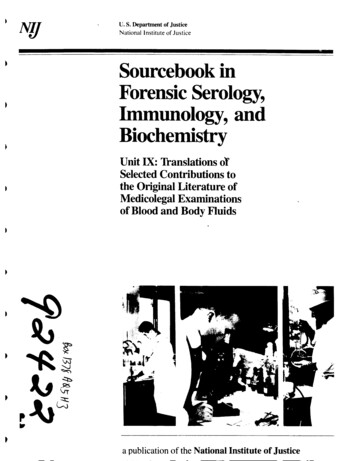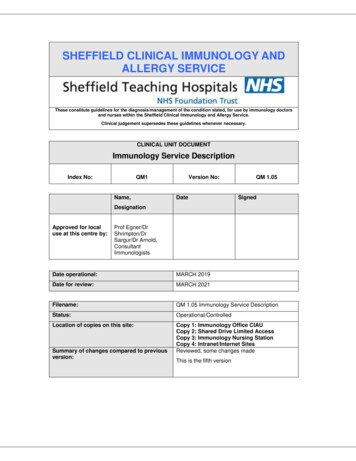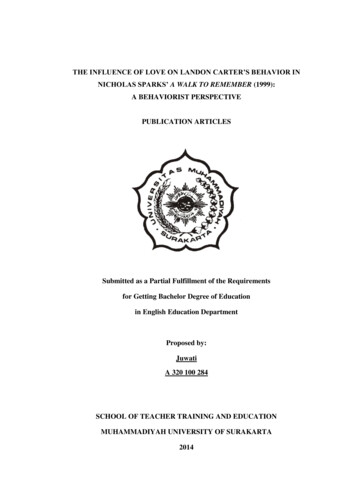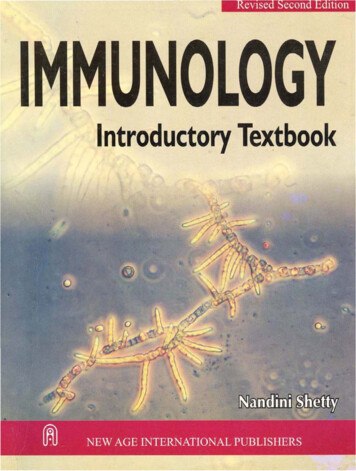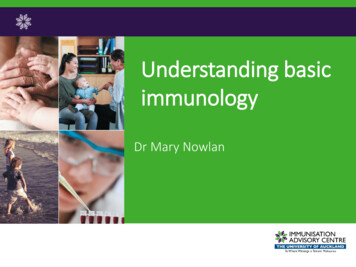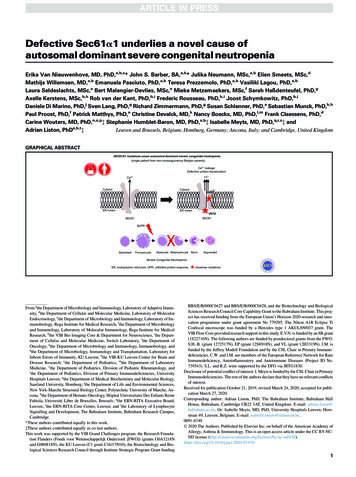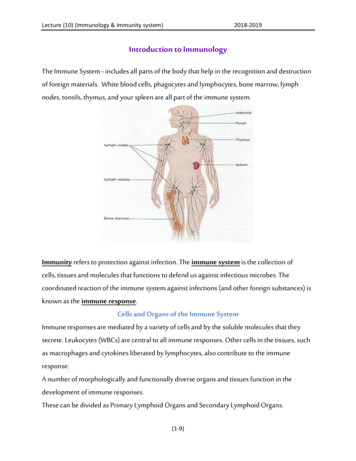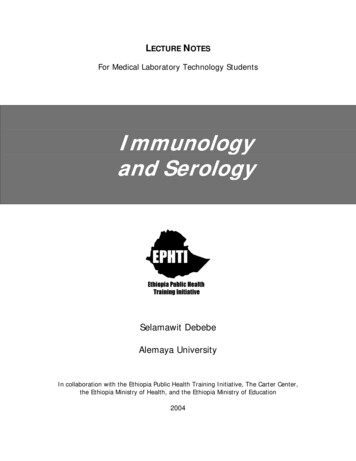
Transcription
LECTURE NOTESFor Medical Laboratory Technology StudentsImmunologyand SerologySelamawit DebebeAlemaya UniversityIn collaboration with the Ethiopia Public Health Training Initiative, The Carter Center,the Ethiopia Ministry of Health, and the Ethiopia Ministry of Education2004
Funded under USAID Cooperative Agreement No. 663-A-00-00-0358-00.Produced in collaboration with the Ethiopia Public Health Training Initiative, The CarterCenter, the Ethiopia Ministry of Health, and the Ethiopia Ministry of Education.Important Guidelines for Printing and PhotocopyingLimited permission is granted free of charge to print or photocopy all pages of thispublication for educational, not-for-profit use by health care workers, students orfaculty. All copies must retain all author credits and copyright notices included in theoriginal document. Under no circumstances is it permissible to sell or distribute on acommercial basis, or to claim authorship of, copies of material reproduced from thispublication. 2004 by Selamawit DebebeAll rights reserved. Except as expressly provided above, no part of this publication maybe reproduced or transmitted in any form or by any means, electronic or mechanical,including photocopying, recording, or by any information storage and retrieval system,without written permission of the author or authors.This material is intended for educational use only by practicing health care workers orstudents and faculty in a health care field.
Immunology and SerologyPrefaceImmunology and serology is an advanced science dealingwith how the human immune system organized, function andthe different types of serological techniques. It is a very vastsubject covering a wide area of technology.The shortage of reference materials in the area and in orderto present the subject in a relatively simplified and organizedway called the need for preparing a lecture note.This teaching material is prepared based on the existingcurriculum of immunology and serology and consists of 16chapters. Each chapter has its own objective, body andquestions (exercises) at the end. Therefore, the material isdesigned to present clear and concise understanding aboutimmunology and serology; and it is primarily suitable forstudents following diploma programme in medical laboratorytechnology.Finally, it is quite obvious that it had demanded a lot of effortin preparing this material. However, it should be noted thateven then, there could be constructive comments which arehelpful in improving this lecture note.Thus, it will be wellaccepted and acknowledged for the contribution.i
Immunology and SerologyAcknowledgmentsI would like to acknowledge The Carter Center initiative forsupporting the preparation of this lecture note.My deepest appreciation also goes to Alemaya UniversityFaculty of Health Sciences staff who have an input in one oranother way.I am also very grateful to medical laboratory technology staffof JU, DCTEH, GCMS, for their valuable comments and ideasin revising the first draft.Finally, I wish to extend my thanks to W/t AschalechTemesgen for writing me the draft of this lecture note.ii
Immunology and SerologyAbbreviationsCRP-C-reactive ProteinEBV-Epstien-Barr VirusEIA-Enzyme Immune AssayHCG-Human Chorionic GonadotrophinPMN-Polymorphonuclear Leukocytesiii
Immunology and SerologyTable of ContentsPrefaceAcknowledgementAbbreviationsTable of ContentsCHAPTER ONE: INTRODUCTION TOIMMUNOLOGY-SEROLOGY1.1 Historical back groundCHAPTER TWO: IMMUNITY2.1 Definition of immunityCHAPTER THREE: THE LYMPHOID SYSTEM3.1 Lymphoid tissue3.2 The lymphocytesCHAPTER FOUR: THE ANTIGEN, ANTIBODIESAND THE COMPLEMENT SYSTEM4.1 Antigen4.2 Antibodies4.3 Immunoglobulin4.4 Complement systemiv
Immunology and SerologyCHAPTER FIVE: THE CELLULAR IMMUNITY5.1 Cell mediated immune response5.2 delayed type of hypersensitivity5.3 Autoimmune diseaseCHAPTER SIX: ANTIGEN- ANTIBODYINTERACTION6.1 Principle of antigen antibody interaction6.2 In vitro antigen antibody reaction6.3 Factor affecting antigen antibody reactionCHAPTER SEVEN: SEROLOGICAL TECHNIQUES7.1 Materials necessary for basic serology tests7.2 Collection, preparation and preservation ofspecimen for serologic test7.3 Shipment of serologic specimen7.4 Complement inactivation7.5 Serial dilution7.6 determinations of end point and titerCHAPTER EIGHT: SYPHILIS SEROLOGY8.1 Treponematoses8.2 Syphilis8.3 Tests for syphilisv
Immunology and SerologyCHAPTER NINE: AGGLUTINATION TEST FORFEBRILE DISEASES9.1 Typhoid and paratyphoid fever9.2 Rickettsial diseases9.3 Brucella abortusCHAPTER TEN: HUMAN CHORIONICGONADOTROPIN HORMONE10.1 HCG and pregnancy10.2 Pregnancy test10.3 Specimen collection10.4 Factors affecting pregnancy testsCHAPTER ELEVEN: HUMANIMMUNODEFICIENCY VIRUS11.1 Disease characteristics and clinicalmanifestation11.2 Laboratory diagnosisCHAPTER TWELVE: HEPATITIS VIRUSCHAPTER THIRTEEN: C-REACTIVE PROTEINCHAPTER FOURTEEN: INFECTIOUSMONONUCLEOSIS14.1. Epistien-Barr Virusvi
Immunology and Serology14.2 hetrophil antibodies14.3 Serological testsCHAPTER FIFTEEN: STREPTOLYSIN OCHAPTER SIXTEEN: RHEUMATOID FACTORGLOSSARYBIBLIOGRAPHYvii
Immunology and SerologyCHAPTER ONEINTRODUCTION TO IMMUNOLOGYSEROLOGYAt the end of this chapter, the reader should be able to:-Define the term immunology-Describe the historical background of immunology1.1 Historical Background of ImmunologyImmunology is defined as the study of the molecules, cells,organs, and systems responsible for the recognition anddisposal of foreign material. Immunology began as a branchof microbiology. The study of infectious disease and thebody’s response to them has a major role for the developmentof immunology. More over, the concept of germ theory ofdisease has contributed to the field of immunology.It was Edward Jenner who first studied the response of thebody to foreign substances. He observed that dairy maidswho had naturally contracted a mild infection called cowpoxseemed to be protected against smallpox, a horriblydisfiguring disease and a major killer.1
Immunology and SerologyIn 1796, Jenner inoculated an eight year-old boy with fluidfrom cowpox blisters on the hand of a dairymaid. The boycontracted cowpox. Then two month later Jenner inoculatedhim with fluid from a small pox blister, the boy only developeda small sore at the site of inoculation. His exposure to the milddisease cowpox had made him immune to the small poxinfection. These were some of the vital events occurred in thehistory of immunology following Jenner’s achievement.In 1879, the first human pathogen, gonococcus, was isolatedby Neisser. In 1883, Klebs and Loeffler isolated diphtheriabacilli which led to the production of the first defined antigen,diphtheria toxin, by Roux and Yersin in 1888. In the sameyear the first antibodies, serum bactericidins, were reported byNuttal and Pasteur.In 1890, von Behring and Kitasato discovered antitoxins thatled to the development of toxoids for diphtheria and tetanus.In 1900, Land Steiner discovered the blood group antigensand their corresponding antibodies. This led to the ability togive blood transfusion with out provoking reactions. It was in1916 that the first journal of immunology began publication inwhich many of new findings published on it. In general,immunology has always depended on and stimulated theapplication of technology, such as the use of ce,2etc.Thus
Immunology and Serologyimmunology has not become an inborn discipline but hasmaintained close associations with many other fields ofmedical sciences.3
Immunology and SerologyReview Questions1. Who was the first person studied the body’s response toforeign substance?2. Describe the development of the field immunology3. What was the contribution of Land Steiner for the field ofimmunology?4
Immunology and SerologyCHAPTER TWOIMMUNITYLearning ObjectivesAt the end of this chapter, students are expected to:-Describe the different types of immunity-Explain the role of the immunity in defense mechanism-Discuss factor that affect the immunity2.1. DefinitionImmunity can be defined as the way in which the body canprotect itself from invasion by pathogenic microorganism andprovide a defense against their harmful effect.Immunity is classified in to two major groups-Non specific immunity-Specific immunity2.1.1. Non specific (natural or innate) immunity.Non-specific immunity, also called natural or innate immunity,is the first line of defense against any infectious agent. Nonspecific host responses provide an effective barrier that5
Immunology and Serologyprevents the microorganisms from penetrating, inhibit ordestroy the invader if it gains access to the tissues, andeliminate or neutralize any toxic substance elaborated byinfectious agent. Several mechanisms are available in theimmunocompetent host. These include physical or mechanicalbarrier, biochemical factors, cellular mechanism, role ofnormal flora & inflammatory reactions.Physical or mechanical barrierThe unbroken skin and mucus membrane are effectivemechanical barriers to infectious agents. The surface of theskin is also inhibitory to the growth of most microorganismsbecause of low moisture, low pH, and the presence ofsecreted inhibitory substance. However, it is possible forsome microorganisms to enter the skin through hair follicles,sebaceous glands or sweet glands.Similarly, mucus membranes consist of an epithelial layer andan underlying connective tissue layer. They line the entiredigestive, respiratory, urinary, and reproductive tracts. Forexample, the epithelial surface that lines the nasal cavity andthroat are protected by a combination of mucous productionand cilliary movement. Because mucous is so viscous,microorganisms adhere to it. Epithelial cells with ciliaconstantly move the mucus layer to ward the mouth, where it6
Immunology and Serologyalong with the trapped microorganism is swallowed andeliminated.Besides, the action of coughing removes mucus that containsmicroorganisms. In the urethra rapid flow of urine washesaway most microorganisms. Tear that wash the conjunctivaperform a similar defensive function.Biochemical factorsThese are chemical secretions produced by the body thatinhibit microbial growth. The following are included as anexample, keratin is a skin protein produced by the outher mostcells of the skin, since it has very little water, the skinbecomes very dry and therefore to most species ofmicroorganism. The growth of microorganisms is inhibited inthe gastrointestinal tract by hydrochloric acid and bile salt,which are secreted by the stomach and liver, respectively.Lysozyme is an enzyme found in many body fluids andsecretions such as tears. It can break down the cell wall ofGram-positive bacteria and a few gram-negative bacteria byhydrolyzing the peptidoglycan layer.Complement is a family of more than twenty different proteinsin serum that function as a non-specific defense againstinfection.7
Immunology and SerologyInterferons are small proteins produced by eucarytic cells inresponse to viral infection. The virally infected cell producesinterferon for a few hours, even for a day, and it will excreteand used by other cells. When these cells become infectedwith the same or unrelated virus, the interferons cause thecells to produce molecules that prevent replication of theinfecting virus.Cellular mechanismAlveolar macrophages like neutrophils and natural killersremove particles and organisms that enter the alveoli.Neutrophils are the first phagocytes in the infected area thatcan non-specifically phagocytize some microbes. Natural killercells are large lymphocytes whose function is to killundesirable cells such as tumor cells and virus infected cells.Role of normal floraThe human body is inhabited by a large number ofmicroorganisms, mainly bacteria, which together, are calledthe body’s normal flora or commensals. The term normal floraimplies that such microbial inhabitants are harmless For themost part, normal flora microorganisms do not cause disease.The commensal can stop the growth of potentially pathogenicorganisms through different mechanism such as occupyingattachment sites and by producing substance against8
Immunology and Serologypathogenic organism. They also compete for essentialnutrients for their growth.Inflammatory reactionsThe inflammatory response is the vascular and cellularreaction to the presence of invading microorganisms or injury.It is one of the most effective defense mechanism in humanand other animals. The process of inflammation may bedivided in to the following stages: Initiation (Damage to tissue) Tissue response Leukocyte response Tissue repair (resolution) Cure.The damaged cells at the site of injury initiate the tissueresponse by releasing chemical factors such histamine, whichin turn trigger vasodilatation and increased permeability ofcapillaries, permitting influx of fluids and blood cells in to thesite. Then, the phagocytic cells accomplish the leukocyteresponse, by engulfing the microbes and damaged tissue.In addition to destroying and removing an injurious agent suchas a microbe or its products, the inflammatory response alsolimits the effects of the agent or its products by confining it orwalling it of from the surrounding tissues. This is possible9
Immunology and Serologybecause blood clots around the site prevent the microbe or itsproducts from spreading to the other part of the body.The final stage of inflammation is tissue repair, when allharmful agents or substances have been removed orneutralized at the injury site. The ability of a tissue to repair itself depends on the part of the tissue involved. Skin, being arelatively simple tissue has a high capacity for regeneration.But nerve tissue in brain, appears not to regenerate.2.1.2. Specific immunityThe specific immune response, also called acquired oradaptive immunity, is a defense system that protects the bodyagainst pathogenic microorganisms and other type of diseasesuch as cancer. It allows the body to recognize, remember,and respond to a specific stimulus, an antigen. Specificimmunity can result in the elimination of microorganisms andin the recovery from disease, and it frequently leaves the hostwith specific immunologic memory. This condition of memoryor recall, acquired resistance, allows the host to respond moreeffectively if reinfection with the same microorganism occurs.As a consequence of such acquired immunity, we usuallysuffer from many diseases only once, for example measles.Specific immunity can be active or passive, and each of thesetypes can in turn be naturally or artificially acquired.10
Immunology and SerologyPassive immunityIt is an immunity in which antibodies produced elsewhere aregiven to the individual. They are divided into two:I. Naturally acquired passive immunity: refers to antibodiestransferred from mother to fetus across the placenta and tothe newborn in colostrums and breast milk during the first fewmonths of life.ii. Artificially acquired passive immunity: is introduction ofantibodies that are formed by an animal or a human to anindividual to prevent or treat infection.Active immunityIt is a product of the individual’s own immune system inresponse to a foreign antigen.I. Naturally acquired active immunity: is immunity thatcomes from infections encountered in daily life.ii. Artificially acquired active immunity: It is stimulated byinitial exposure to specific foreign macromolecules throughthe use of vaccines to artificially establish a state of immunity.11
Immunology and Serology2.3. Factors Associated With ImmunologicDiseaseMany factors appear to be responsible for differences in theimmunity of individual’s age; nutrition & genetic factor aresome of them.AgeAlthough non-specific and specific body defense are presentin the unborn and newborn infants, many of these defensesare not completely developed in this group. There fore youngchildren are at greater risk for disease. In older adults certainnatural barriers to infection break don such as changes in theskin & in the lung weakening of specialized defenses againstforeign invasion including the cough reflex.In general, the ability to respond immunologically to disease isage related.NutritionThe importance of good nutrition to good health has alwaysbeen emphasized. Good nutrition is known to be important togrowth and development. The consequences of diet in manyaspects of the immune response have been documented inmultiple disorders. Every constituent of the body defenseappears to influence by nutritional intake. Therefore a healthy12
Immunology and Serologydiet is important for maximum functioning of the immunesystemGenetic factorsThe possession of certain genes is linked to immunedisorders these include genes that lead to a deficiency in theproduction of neutrophilis & complement.Sickle cell disease predisposes to pneumococcal bacteraemiaor Haemophilus influenza and E. coli infection.13
Immunology and SerologyReview Questions1. What are the non-specific immunity2. What are the steps involved in inflammatory reaction3. Write the difference between active and passive immunity4. Explain the factors that affect the immunity14
Immunology and SerologyCHAPTER THREETHE LYMPHOID SYSTEMLearning ObjectiveAt the end of this chapter, students are expected to:-Describe about primary and secondary lymphoid organ-Explain about clonal selection theory-Explain the difference between primary and secondaryimmune response3.1 Lymphoid TissueThe immune system is a network of cells and organs thatextend through out the body and function as a defenseagainst infection. The immune system has been recognizedas a separate body system known as lymphoid systembecause its main cells are lymphocytes.In mammalian immunologic development, the precursors oflymphocytes arise from progenitor cells of the yolk sac andliver. Later in fetal development and throughout the life rentiated progenitor cells, which can further develop in15
Immunology and Serologyto lymphoblast. Continued cellular development of lymphoidprecursors and proliferation occurs as the cell travel to theprimary and secondary lymphoid tissues.3.1.1 The Primary Lymphoid OrganThe thymus and bone marrow are referred to a roenvironments that are essential for initial production oflymphocytes from progenitor cells.The thymus is a gland situated in front of the heart and behindthe sternum. Progenitor cells that leave the bone marrowmigrate to the thymus for proliferation and differentiation. ferentiated cell is known as thymus- derived T cell.Involution of the thymus is the first age-related changeoccurring in the immune system of humans. The thymusgradually loses up to 95% of its mass during the first fiftyyears of life. This will result in decreased synthesis of thymichormone and loss of the ability to differentiate immaturelymphocytes are reflected in an increased number ofimmature lymphocytes both with in the thymus and circulatingperipheral blood T-cells.16
Immunology and SerologyBone marrow is the source of progenitor cells. These cells candifferentiate in to lymphocytes, granulocytes, erythrocytes,etc. The bone marrow also plays a role in the differentiation ofprogenitor cells into B-lymphocytes and functions as the bursaequivalent in human. It is from the term bursa, that the Blymphocytes derived their name. Bursa of fabricius is theprimary lymphoid organ in birds.B-lymphocyte differentiations in the bone marrow continuethrough out lifetime. Mature lymphocytes that emerge form thethymus or bone marrow are in a “resting” state. They aremitotically inactive although they are potentially capable ofundergoing cell division and of carrying out immunolgicfunctions, they are not yet been stimulated to do either whendispersed in to the blood stream, they are known as ‘naïve’ or‘virgin’ lymphocytes.3.1.2 Secondary Lymphoid OrganThe secondary lymphoid organs include lymph nodes, spleen,gut-associated lymphoid tissue, tonsils, blood and others, in towhich the so-called ‘virgin’ lymphocytes migrates efficiently.The function of the secondary lymphoid organs is to maximizeencounters between lymphocytes and foreign substances,and it is from this site that most immune responses arelaunched.17
Immunology and SerologyThe relative percentage of T and B cells are different phocytes in lymphoid organs is described in table 3.1.Lymph nodesLymph nodes act like lymphoid filters in the lymphatic system.It responds to antigens introduced distantly and routed tothem by afferent lymphatic. Generalized lymph node reactivitycan occur following systemic antigen challenge.SpleenThe spleen act like a lymphatic filter with in the blood vasculartree. It is an important site of antibody production in responseto intravenous particulate antigen (e.g. bacterial). The spleenis also a major organ for the clearance of particles.Gut – associated lymphoid tissue (GALT)Gut-associated lymphoid tissue includes lymphoid tissue inthe intestines (payer’s patches) and the liver. Gut associatedlymphoid tissue is involved in lymphocyte circulation, i.e. preB cells develop in payer’s patches and after meeting antigenfrom the gut, they enter to the general circulation and thenreturn back to the gut.18
Immunology and SerologyTonsilsTonsils are nodular aggregates of lymphoid tissues, theirfunction is to detect and respond to pathogens in therespiratory secretion.BloodThe blood is an important lymphoid organ and immunologiceffector tissue. Circulating blood has enough mature T-cells toproduce graft- versus- host reaction.Table 3.1 approximate percentages of lymphocytes inlymphoid organsLymphoid Lymph nodes6040Spleen4555Bone marrow1090Source: immunology & serology in laboratory medicine, page 64.Most virgin lymphocytes have an inherently short life span andare programmed to die within a few days after leaving themarrow or thymus. How ever, if a cell receive signals thatinduce the presence of a specific foreign substance orpathogen, it may respond to it by a phenomenon known as19
Immunology and Serologyactivation. In the process it may under go several successivecell divisions over a period of several day. Some of theresulting progeny cells then revert to the resting state tobecome memory lymphocytes (cells that resemble the virginlymphocytes from which they are derived but which cansurvive for many years). The other progeny of an activated‘virgin’ lymphocyte differentiate into effector cells, whichsurvive for only a few days to carry out specific defensiveactivities against the foreign invader.Bone marrowStem cellsThymusProcessingBone marrowProcessingT lymphocyteB-lymphocytesTransported inbloodIn secondary lymphoid organsT ooperationEffector cellseffectors cells(Plasma cells)(Lymphoblasts)Cell – mediatedreactionsmemory cellsHumoral antibodysynthesisFigure 3.1 - Distinction between T lymphocytes and B-lymphocytes. Source:ndPrinciples of Microbiology, Ronald M-Atlas, 2 edition, 1997 pp524.20
Immunology and Serology3.2 The lymphocytesThe lymphocytes are one of the classes of white blood cells,capable of responding to antigens in specific host defensemechanism. Under the microscope, all lymphocytes look like,differing only in size and other physiologically lhomogeneity, there is a hidden homogeneity. First, thelymphocytes fall in to three large sets, the T, B. and naturalkiller (NK) cells. The NK cells constitute a special category;we will there fore leave them and focus on T and B cells. TheT and B sets are splited in to subsets defined by a variety ofcriteria. Finally, each subset is a mosaic of clones, each cloneexpress a specific receptor for a different antigenic eptiope.3.2.1. Clonal Selection TheoryLymphocytes have surface receptors specific for differentantigens. As these cells differentiate and each of sequently excluded form expressing all other receptorgenes. The progeny of a given cell will therefore express thesame gene and the same receptor. It will thus form a clone, agroup of cells that are derived from the same ancestral thelymphocyte population of a vertebrate is a mosaic of store21
Immunology and Serologyselling shoes of all possible sizes. The customer entering thestore (the antigen or epitope binding to the receptor) selects rchases it (stimulates the lymphocytes). The selectedlymphocyte then divides and the progeny form a clone ofidentical specificity (clonal selection).The fundamental property of lymphocytes is that all of the Bcell or T cell receptor proteins expressed by cells in a givenclone are identical. All have precisely the same amino acidsequence.The speed and intensity of response to a given antigen isdetermined largely by clonal selection. The larger the specificclone, the more lymphocytes are available that can recognizethe antigen and can participate in the immune response.Burnet first postulated the principle of clonal selection, in the1950s.3.2.2. B-lymphocytesB-cells represent less than 15% of the circulating lymphocytesand are derived from progenitor cells through an antigenindependent maturation process occurring in the bone marrowand GALT. These cells serve as the primary source for cells22
Immunology and Serologyresponsible for hurmonal (antibody) response, which is aprimary host defense against microorganisms.B- lymphocytes and humoral responseParticipation of B-cells in the humoral immune response isaccomplished by their stimulation in to plasma cells, withsubsequent synthesis and secretion of immunogobulins afterantigenic stimulation.The humoral immune response; stimulation of B-cells crophages, T-cells and B-cells. In order to recognizeantigens, B-cells usually require the cooperation of antigenpresenting cells. Macrophages are the major antigenpresenting cells that phagocytize, process and presentantigen to T-cells. The T-cell that contain an antigen on itssurface bound with a specific antigen receptor of B-cell knownas B-cell receptor as a result the B-cell recognize its specificantigen and it become activated.Activation causes the selected B-cell to divide producingclone. It also causes the B-cells to differentiate further in toplasma cells, which produce the enormous quantity ofantibodies needed to fight infection. Some members of thisclone become effector cells that actively fight the current23
Immunology and Serologyinfection while others remain as memory B-cells that are heldin reserve to fight future infection by the same antigen.Plasma cells are the end stage of B-cells differentiation, whichare capable of synthesing and excreting antibodies. Plasmacells are not found normally in the circulating blood.Primary and secondary humoral immune responseB cells can be stimulated in their resting state to enlarge,divide, mature and secrete antibody. The proper signal for thissequence depend on the type of antigen (foreign material) i.e.exposure of antigen for the first time or second exposure.Depending on the type of espouser the immune response alsovary.Primary immune responseThe production of antibody during a primary immune responseoccurs when a person first encounters a particular antigen.The type of antibody first appear are of the IgM class. Theproduction of detectable serum IgM may take 1-2 weeks theproduced antibody will decline with in short period.Secondary immune responseSecondary immune response is initiated by memory B-cellswhen there is second exposure with similar antigen. IgG is themajor antibody produced in secondary immune response. The24
Immunology and Serologyproduction of this antibody in detectable amount may takevery short time as compared to the primary response. The IgGmay persist for many months or years. The secondaryimmune response has high affinity than primary immuneresponse because of the memory B-cells.25
Immunology and SerologyReview Questions1. Write the site that B-cell and T-cell proliferation takesplace2. Describe the function of secondary lymphoid organs.3. Discuss what clonal selection mean4. Describe the difference between primary and secondaryhumoral immune response.26
Immunology and SerologyCHAPTER FOURANTIGENS, ANTIBODIES AND THECOMPLEMENT SYSTEMLearning ObjectivesAt the end of this chapter, students are expected to:-Describe the characteristics of antigens and antibodies-Explain the different classes of immunoglobulin-Describe the two path way of complement activation-Discuss the role of complements in immune response4.1 AntigensAntigens are substances that are recognized by a particularimmunoglobulin or T-cell receptor and they can serve as thetarget of an immune response.Immunogens are any substance that is capable of inducing animmune response.Antigenic determinant or epitope is the specific site to which aparticular immunologlobulin or T-cell receptor binds.27
Immunology and SerologyMany immunogens, including all microbial pathogens, arecomplex assemblages containing several different types ofmolecules, not all of which are antigenic.Not all antigens are immunogenic i.e. not every chemicalsubstance that can be bound by an immunoglobulin iscapable of inducing an immune response.Antigenic molecules may be multivalent, having multipleepitope, or monovalent, having only one epitope. Generally,multivalent antigens produce a stronger immune responsethan monovalent antigens because wide arrays of antibodymolecules are made against the multiple antigens.Adjuvants
infectious agent. Several mechanisms are available in the immunocompetent host. These include physical or mechanical barrier, biochemical factors, cellular mechanism, role of normal flora & inflammatory reactions. Physical or mechanical barrier The unbroken skin and mucus membrane are effective mechanical barriers to infectious agents.

